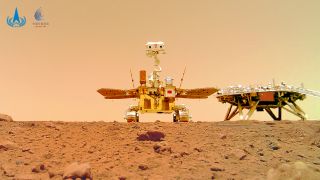China finally admits its hibernating Mars rover may never wake up
The Zhurong Mars rover never woke up from a planned hibernation, and the head of the mission team has now revealed why.

After months of silence, Chinese government officials have finally revealed the fate of the nation's robotic Mars explorer, which stopped moving nearly a year ago.
Zhurong, China's first Mars rover, is likely covered in dust, coating its solar panels and making it impossible to generate enough power to wake up from a planned hibernation, Zhang Rongqiao, chief designer of China's Mars exploration program, told China's state television CCTV, according to Al Jazeera (opens in new tab).
This scenario has long been considered the most likely reason that Zhurong never woke up from the hibernation it entered in May 2022. The rover was expected to wake again in December 2022 as winter in the Martian northern hemisphere drew to a close and sunlight became more abundant, but the rover remained quiet. In March, NASA images of the Red Planet showed the rover in the same position where it had entered its hibernation period, nearly one year earlier.
There was hope that an unusually cold Martian winter was to blame and that perhaps the rover might wake when temperatures rose. But Zhang's comments on Tuesday indicate that dust is the most likely culprit. The rover exceeded its original mission time by three months, exploring a broad plain on Mars known as Utopia Planitia for 358 days before it went silent, Zhang said. In that time, the rover traveled 6,302.5 feet (1,921 meters).

The rover landed on Mars in 2021 with the goal of studying Martian rocks, soil, magnetic fields and weather. According to a description published in 2021 in the journal Innovation (opens in new tab), the rover carried six instruments, including subsurface detector radars, a surface composition detector, a surface magnetic field detector, a multispectral camera, a weather station and a camera for navigating the Martian terrain. The name Zhurong comes from the god of fire in Chinese mythology.
During its time on Mars, the rover snapped a selfie and captured images of the Martian surface. It recorded the sound of the Martian wind and took part in experiments in relaying information between the European Space Agency and the China National Space Administration.
NASA's Perseverance and Curiosity rovers continue to explore the Martian surface. According to NASA (opens in new tab), China's future space plans include a sample-return mission to the moon and detailed surveys of the lunar south pole.
Live Science newsletter
Stay up to date on the latest science news by signing up for our Essentials newsletter.
Stephanie Pappas is a contributing writer for Live Science, covering topics ranging from geoscience to archaeology to the human brain and behavior. She was previously a senior writer for Live Science but is now a freelancer based in Denver, Colorado, and regularly contributes to Scientific American and The Monitor, the monthly magazine of the American Psychological Association. Stephanie received a bachelor's degree in psychology from the University of South Carolina and a graduate certificate in science communication from the University of California, Santa Cruz.